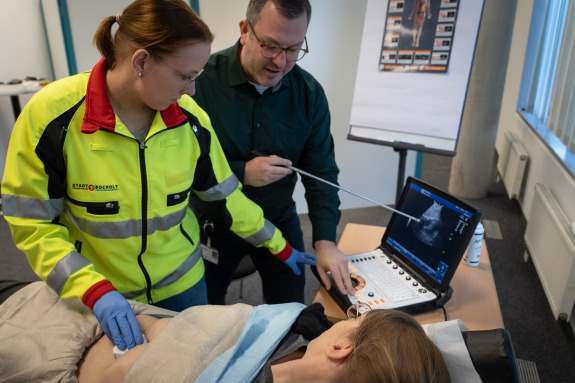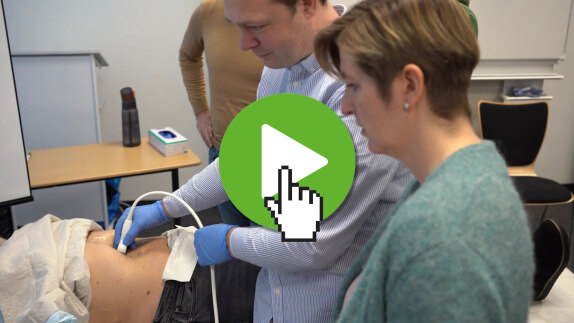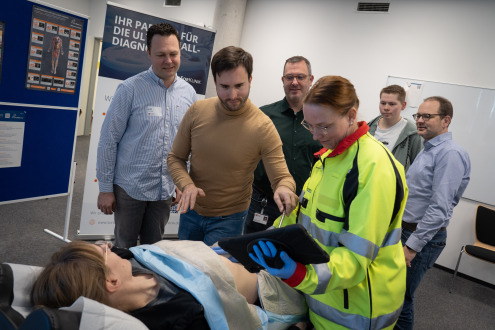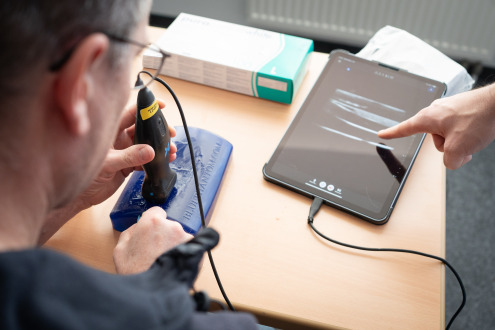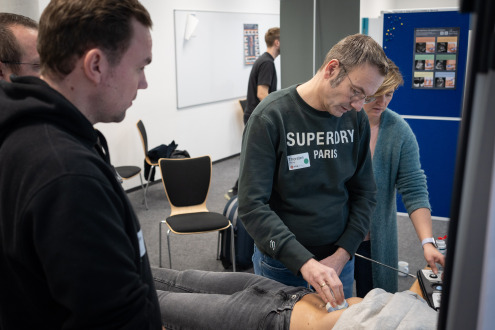11. January 2024
Fire and Rescue Service Academy
Ultrasound to support rescue services in the future
Bocholt - As one of the first districts in Germany, the rescue service in the Borken district will in future be using a well-known diagnostic tool in the training of emergency paramedics: ultrasound.
If a seriously ill or injured person in the Borken district needs help quickly, the rescue service will be on the scene within a few minutes. Well-trained specialist staff, consisting of emergency doctors and paramedics, look after patients in an emergency and can take the first life-saving measures at the scene of the emergency with a wide range of therapeutic options.
While emergency medical personnel used to be called in for many operations, well-trained emergency paramedics are now accorded a higher status within first aid. This professional group can now also initiate numerous therapies independently and without the support of emergency physicians. However, despite an extensive range of therapeutic measures, the diagnostic options are very limited. For example, in addition to a stethoscope and a blood glucose meter, the ambulance only has an ECG to narrow down the list of possible diagnoses.
Structured training for emergency services
As one of the first districts in Germany, the rescue service in the Borken district will therefore be using a well-known diagnostic tool for the training of emergency paramedics in future: ultrasound.
In the past, ultrasound devices were only operated in a clinic with a permanent power connection due to their size, but the latest generation of devices can now be connected to a smartphone.
This makes it possible to obtain important information about the patient's condition at the scene of the emergency in order to support patient care. Emergency physicians at many locations in Germany are already using this technology.
However, the majority of patients in the ambulance service are treated by the ambulance team alone. They must then be able to make the correct initial assessment independently, which has a significant influence on the choice of treatment and transport destination.
Further applications conceivable in the future
As part of the "5G-Telerettung" project, 12 members of the ambulance service underwent sonography training in a trial phase back in June 2023. From 2024, all emergency paramedics in the Borken district ambulance service will now receive extensive training in the basics and use of sonography on emergency patients. This project will be realised in collaboration with SonoForKlinik over the next two years at the Bocholt Fire and Rescue Service Academy (FRB).
"We have been focussing on future-oriented and comprehensive training for our employees for years. The integration of sonography training is the next logical step to increase the level of expertise of our staff and ultimately provide even better first aid to the citizens of the district", explains Hanjo Groetschel, Medical Director of the Rescue Service and Emergency Doctor in the Borken district.
Project receives scientific support
Jan Neukäter, Head of the Rescue Service School at the FRB, is also looking forward to the new training programme: "The benefits of sonography in emergency situations have been known for years. Until now, however, there has been little knowledge about whether and how sonography can support the work of German paramedics.
This is why we are initially investigating the learning success in a study as part of this pilot project in order to gain scientific findings for possible integration into the work of our employees", explains Neukäter. "Independent of the later use of sonography on patients, sonographic training alone increases the knowledge of the employees through the intensive repetition and visualisation of the anatomy, so that one can only speak of a promising training model here, which should also be integrated into the training of emergency paramedics."
As a first step, all employees will be taught basic skills so that they can work together with emergency medical staff on sonographic diagnostics in the future and build up their own examination skills. Initial equipment is also to be procured for the rescue vehicles.
Telemedicine in particular could play a key role here, as examination by emergency paramedics and simultaneous interpretation by a tele-emergency doctor is a realistic prospect in the future thanks to improved network coverage and the use of new infrastructures.



